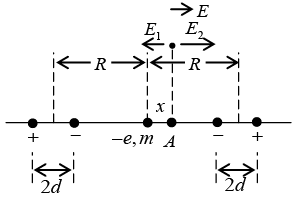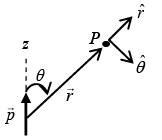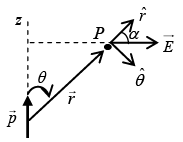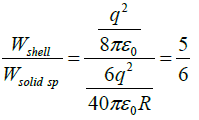Electrostatic Energy, Conductors & Electric Dipole: Assignment | Electricity & Magnetism - Physics PDF Download
Q.1. Consider two concentric conducting spherical shells with inner and outer radii a, b and c, d as shown in the figure. Find the surface charge density on each surface if:
(a) +q charge is given to outer shell only.
(b) +q charge is given to inner shell only.
(c) +q charge is given to inner shell and +q charge is given to outer shell.
(d) - q charge is placed at the centre only.
(e) Both the shells are given +q amount of positive charges. In order to have equal surface charge densities on the outer surface of both the shells, then find the relation between b and d .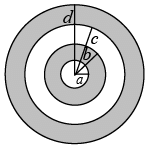
(a)
(b)
(c)
(d)
(e)
Q.2. A conducting sphere of radius R has charge Q on its surface and its electrostatic energy is U. If the charge on the sphere is doubled and its radius is halved, then find the electrostatic energy.
Q.3. An electron of charge e and mass 2m is located at the midpoint of the line joining two fixed collinear dipoles with charges e as shown in the figure. (The particle is constrained to move only along the line joining the dipoles). Assuming that the length of the dipoles is much shorter than their separation, the natural frequency of oscillation of the particle is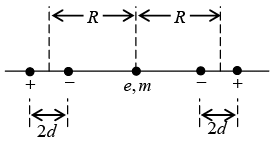
Let us displace the charge particle by small amount x at A .
Field due to first dipole is
Field due to second dipole is
Then the resultant electric field at point A is given by E = E2- E1 ∵ E2 > E1
Then
Q.4. A point dipole with dipole moment  is oriented in the z -direction and located at the origin.
is oriented in the z -direction and located at the origin.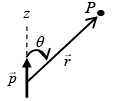 (a) Find the projection Ez of the electric field strength vector at the point P .
(a) Find the projection Ez of the electric field strength vector at the point P .
(b) Find the projection E⊥ of the electric field strength vector (on the plane perpendicular to z -axis at the point P ).
(c) Find the angle θ at which  is perpendicular to
is perpendicular to  at point P .
at point P .
(a)
(b)
(c)
Q.5. The electric fields outside (r >R) and inside (r <R) a solid sphere with a uniform volume charge density are given by  respectively, while the electric field outside a spherical shell with a uniform surface charge density is given by
respectively, while the electric field outside a spherical shell with a uniform surface charge density is given by  being the total charge. Find the correct ratio of the electrostatic energies for the second case to the first case.
being the total charge. Find the correct ratio of the electrostatic energies for the second case to the first case.
Electrostatic energy in spherical shell
Electrostatic energy in solid sphere
Now
Q.6. Two electric dipoles P1 and P2 are placed at (0, 0, 0) and (1, 0, 0) respectively with both of them pointing in the +z direction. Without changing the orientations of the dipoles P2 is moved to (0, 3, 0) . Find the ratio of the electrostatic potential energy of the dipoles after moving to that before moving.
Electrostatic potential energy
Q.7. Four charges are situated at the corners of a square (side a) as shown in figure. How much work does it take to assemble the whole configuration of four charges?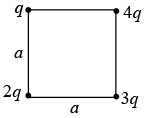
Work done in placing first charge ( q charge upper left corner) W1 = 0
Work done in placing second charge ( 2q charge lower left corner)
Work done in placing third charge ( 3q charge lower right corner)
Potential at fourth corner ( 4q charge upper right corner)
Total work done
Q.8. A small charged spherical shell of radius 0.01 m is at a potential of 30V. Find the electrostatic energy of the shell.
Thus
Q.9. The potential V due to a electric dipole  at a point
at a point  is given by
is given by  If
If  is directed along the positive z -axis, then find then x, y and z -component of the electric field, at the point
is directed along the positive z -axis, then find then x, y and z -component of the electric field, at the point  .
.
Q.10. For a point dipole of dipole moment  located at the origin find:
located at the origin find:
(a) The electric field at (0, b, 0).
(b) The electrostatic potential at (b, 0, 0).
(c) Force experienced by a charge q kept at (0, 0, b).
(d) The work done in moving a charge q from (0, b, 0) to (0, 0, b).
(e) Electric flux through a spherical surface enclosing the origin.
(a) At(0,b,0);
(b) The electrostatic potential at ( b, 0, 0 ) is V (b, 0, 0 ) = 0 ∵ θ = π/2
(c) At ( 0, 0, b ) ; θ = 0
If a charge q is kept at ( 0, 0, b ) ,
(d) The work done in moving a charge q from ( 0,b,0 ) to ( 0,0,b)
(e) Electric flux through a spherical surface enclosing the origin is zero.
|
82 videos|29 docs|22 tests
|
FAQs on Electrostatic Energy, Conductors & Electric Dipole: Assignment - Electricity & Magnetism - Physics
| 1. What is electrostatic energy? |  |
| 2. How do conductors differ from insulators in terms of electrostatic energy? |  |
| 3. What is an electric dipole in the context of electrostatic energy? |  |
| 4. How does the distance between charges affect the electrostatic energy of an electric dipole? |  |
| 5. Can electrostatic energy be converted into other forms of energy? |  |









